Emission Characteristics of Polycyclic Aromatic Hydrocarbons and Nitro-Polycyclic Aromatic Hydrocarbons from Open Burning of Rice Straw in the North of Vietnam
Abstract
1. Introduction
2. Materials and Methods
2.1. Experimental Design
2.2. PAHs and NPAHs Analysis
2.2.1. Reagents and Chemicals
2.2.2. Extraction Procedure and PAHs and NPAHs Analysis
3. Results and Discussions
3.1. The Distribution and Contribution of PAHs from RS Burning Smoke to the Atmospheric Particulates
3.1.1. Distribution of PAHs in Background Environment
3.1.2. Distribution of PAHs in RS Burning Smoke
3.1.3. Contribution of PAHs from RS Burning Smoke to Atmospheric Particulates
3.2. The Distribution and Contribution of NPAHs in Particulates Emitted from RS Burning
3.2.1. Observation of Primary and Secondary NPAHs from RS Burning
3.2.2. The Concentration Ratio of NPAH/PAH in RS Burning
4. Conclusions
- The total amount of nine PAHs bound to particulate matter in the background environment in suburban areas of Hanoi were different between two harvest seasons. The high proportion of RS subject to open field burning in summer-autumn harvest season contributed to the high level of PAHs in the atmospheric environment.
- The levels the 9 PAHs from RS burning were 254.4 ± 87.8 µg g−1 for PM2.5 and 209.7 ± 89.5 µg g−1 for TSP. Although Flu was the most abundant PAH among detected PAHs in both PM2.5 and TSP, the enrichment of Flu in TSP from burning smoke was higher than that in PM2.5, while the accumulation of BaP and IDP in PM2.5 from burning smoke were much higher than those in TSP. The considerable contribution of BaP and IDP in PM2.5 emitted from RS burning make more attention on the toxicity of PM2.5 from RS burning smoke, in which World Health Organization (WHO) ranked PM2.5 in Group 1 (carcinogenic to human). This result is useful information help to Vietnamese Government pay more attention to control the RS burning practice.
- The amount of PAHs in PM2.5 in the present study were 10 times lower than those from RS burning in Thailand, however the concentration ratio of PAHs relative to BkF were higher in comparison to the results from RS burning in Thailand. This variation may relate to rice composition and need to have further study.
- The 1-NP and 6-NC was observed from RS burning. However, their concentrations were in the same range with those from wood burning and much smaller than those from motorcycle exhausts. The 2-NF and 2-NP were observed as the secondary NPAHs in this sampling, in which the formation of 2-NF is more favorable than that of 2-NP. The concentration ratio of 2-NF/1-NP in this sampling was greater than five, which also suggested the relative importance of the gas-phase formation of 2-NF.
- The concentration ratio of mono NPAH to its mother PAH ([1-NP]/[Pyr]) from RS burning was close to the range from coal burning. This fact may associate with the same range of burning temperature between RS burning and coal burning. This research helps to clarify the emission characteristics and the environmental behavior of PAHs and NPAHs from open burning of RS in the north of Vietnam as well as in Southeast Asia.
Supplementary Materials
Author Contributions
Funding
Acknowledgments
Conflicts of Interest
References
- Arey, J.; Zielinska, B.; Atkinson, R.; Winer, A.M.; Ramdahl, T.; Pitts, J.N. The Formation of Nitro-PAH from the Gas-Phase Reactions of Fluoranthene and Pyrene with the OH Radical in the Presence of NOx. Atmos. Environ. 1986, 20, 2339–2345. [Google Scholar] [CrossRef]
- Feilberg, A.; Poulsen, M.W.B.; Nielsen, T.; Skov, H. Occurrence and Sources of Particulate Nitro-Polycyclic Aromatic Hydrocarbons in Ambient Air in Denmark. Atmos. Environ. 2001, 35, 353–366. [Google Scholar] [CrossRef]
- Durant, J.L.; Busby, W.F.; Lafleur, A.L.; Penman, B.W.; Crespi, C.L. Human Cell Mutagenicity of Oxygenated, Nitrated and Unsubstituted Polycyclic Aromatic Hydrocarbons Associated with Urban Aerosols. Mutat. Res. Genet. Toxicol. 1996, 371, 123–157. [Google Scholar] [CrossRef]
- Lewtas, J.; Nishioka, M.G. Nitroarenes: Their Detection, Mutagenicity and Occurrence in the Environment. In Nitroarenes; Springer: Boston, MA, USA, 1990; pp. 61–72. [Google Scholar]
- Murahashi, T.; Miyazaki, M.; Kakizawa, R.; Yamagishi, Y.; Kitamura, M.; Hayakawa, K. Diurnal Concentrations of 1,3-, 1,6-, 1,8-Dinitrophyrenes, 1-Nitropyrene and Benzo(a)Pyrene in Air in Downtown Kanazawa and the Contribution of Diesel-Engine Vehicles. Eisei kagaku 1995, 41, 328–333. [Google Scholar] [CrossRef]
- Yang, X.Y.; Igarashi, K.; Tang, N.; Lin, J.M.; Wang, W.; Kameda, T.; Toriba, A.; Hayakawa, K. Indirect- and Direct-Acting Mutagenicity of Diesel, Coal and Wood Burning-Derived Particulates and Contribution of Polycyclic Aromatic Hydrocarbons and Nitropolycyclic Aromatic Hydrocarbons. Mutat. Res. Genet. Toxicol. Environ. Mutagen. 2010, 695, 29–34. [Google Scholar] [CrossRef]
- IARC Working Group on the Evaluation of Carcinogenic Risks to Humans. Some Non-Heterocyclic Polycyclic Aromatic Hydrocarbons and Some Related Exposures. IARC Monogr. Eval. Carcinog. Risks Hum. 2010, 92, 1–853. [Google Scholar]
- General Statistical Office Vietnam. Statistical Yearbook of Vietnam 2017; Statistical Publishing House: Hanoi, Vietnam, 2017.
- Gadde, B.; Bonnet, S.; Menke, C.; Garivait, S. Air Pollutant Emissions from Rice Straw Open Field Burning in India, Thailand and the Philippines. Environ. Pollut. 2009, 157, 1554–1558. [Google Scholar] [CrossRef]
- Nguyen, M.D. An Estimation of Air Pollutant Emissions from Open Rice Straw Burning in the Red River Delta. Vietnam J. Agric. Sci. 2012, 10, 190–198. [Google Scholar]
- Van Nguyen, H.; Nguyen, C.D.; Van Tran, T.; Hau, H.D.; Nguyen, N.T.; Gummert, M. Energy Efficiency, Greenhouse Gas Emissions, and Cost of Rice Straw Collection in the Mekong River Delta of Vietnam. Field Crops Res. 2016, 198, 16–22. [Google Scholar] [CrossRef]
- Pham, C.T.; Do, T.M.; Nghiem, T.D. Determination of Emission Level of Selected Air Pollutants from Burning of Rice Straw in the Open Field in Gia Lam District, Hanoi. Vietnam J. Agric. Sci. 2018, 16, 152–160. [Google Scholar]
- Jacobs, J.; Kreutzer, R.; Smith, D. Rice Burning and Asthma Hospitalizations, Butte County, California, 1983–1992. Environ. Health Perspect. 1997, 105, 980–985. [Google Scholar] [CrossRef] [PubMed][Green Version]
- Torigoe, K.; Hasegawa, S.; Numata, O.; Yazaki, S.; Matsunaga, M.; Boku, N.; Hiura, M.; Ino, H. Influence of Emission from Rice Straw Burning on Bronchial Asthma in Children. Pediatr. Int. 2000, 42, 143–150. [Google Scholar] [CrossRef] [PubMed]
- Mastral, A.M.; Callén, M.S. A Review on Polycyclic Aromatic Hydrocarbon (PAH): Emissions from Energy Generation. Environ. Sci. Technol. 2000, 34, 3051–3057. [Google Scholar] [CrossRef]
- Lemieux, P.M.; Lutes, C.C.; Santoianni, D.A. Emissions of Organic Air Toxics from Open Burning: A Comprehensive Review. Prog. Energy Combust. Sci. 2004, 30, 1–32. [Google Scholar] [CrossRef]
- Korenaga, T.; Liu, X.; Huang, Z. The Influence of Moisture Content on Polycyclic Aromatic Hydrocarbons Emission during Rice Straw Burning. Chemosph. Glob. Chang. Sci. 2001, 3, 117–122. [Google Scholar] [CrossRef]
- Lu, H.; Zhu, L.; Zhu, N. Polycyclic Aromatic Hydrocarbon Emission from Straw Burning and the Influence of Combustion Parameters. Atmos. Environ. 2009, 43, 978–983. [Google Scholar] [CrossRef]
- Keshtkar, H.; Ashbaugh, L.L. Size Distribution of Polycyclic Aromatic Hydrocarbon Particulate Emission Factors from Agricultural Burning. Atmos. Environ. 2007, 41, 2729–2739. [Google Scholar] [CrossRef]
- Sanchis, E.; Ferrer, M.; Calvet, S.; Coscollà, C.; Yusà, V.; Cambra-López, M. Gaseous and Particulate Emission Profiles during Controlled Rice Straw Burning. Atmos. Environ. 2014, 98, 25–31. [Google Scholar] [CrossRef]
- Zhang, H.; Ye, X.; Cheng, T.; Chen, J.; Yang, X.; Wang, L.; Zhang, R. A Laboratory Study of Agricultural Crop Residue Combustion in China: Emission Factors and Emission Inventory. Atmos. Environ. 2008, 42, 8432–8441. [Google Scholar] [CrossRef]
- Jenkins, B.M.; Jones, A.D.; Turn, S.Q.; Williams, R.B. Emission Factors for Polycyclic Aromatic Hydrocarbons from Biomass Burning. Environ. Sci. Technol. 1996, 30, 2462–2469. [Google Scholar] [CrossRef]
- Nguyen, T.K.O.; Ly, B.T.; Tipayarom, D.; Manandhar, B.R.; Prapat, P.; Simpson, C.D.; Liu, L.J.S. Characterization of Particulate Matter Emission from Open Burning of Rice Straw. Atmos. Environ. 2011, 45, 493–502. [Google Scholar] [CrossRef]
- Nguyen, T.K.O.; Tipayaroma, A.; Ly, B.T.; Tipayaroma, D.; Simpson, C.D.; Hardie, D.; Liu, L.-J.S. Characterization of Gaseous and Semi-Volatile Organic Compounds Emitted from Field Burning of Rice Straw. Atmos. Environ. 2015, 119, 182–191. [Google Scholar]
- Guoliang, C.; Xiaoye, Z.; Sunling, G.; Fangcheng, Z. Investigation on Emission Factors of Particulate Matter and Gaseous Pollutants from Crop Residue Burning. J. Environ. Sci. 2008, 20, 50–55. [Google Scholar]
- Ni, H.; Han, Y.; Cao, J.; Chen, L.W.A.; Tian, J.; Wang, X.; Chow, J.C.; Watson, J.G.; Wang, Q.; Wang, P.; et al. Emission Characteristics of Carbonaceous Particles and Trace Gases from Open Burning of Crop Residues in China. Atmos. Environ. 2015, 123, 399–406. [Google Scholar] [CrossRef]
- Sheesley, R.J.; Schauer, J.J.; Chowdhury, Z.; Cass, G.R.; Simoneit, B.R.T. Characterization of Organic Aerosols Emitted from the Combustion of Biomass Indigenous to South Asia. J. Geophys. Res. Atmos. 2003, 108. [Google Scholar] [CrossRef]
- Chen, K.S.; Wang, H.K.; Peng, Y.P.; Wang, W.C.; Chen, C.H.; Lai, C.H. Effects of Open Burning of Rice Straw on Concentrations of Atmospheric Polycyclic Aromatic Hydrocarbons in Central Taiwan. J. Air Waste Manag. Assoc. 2008, 58, 1318–1327. [Google Scholar] [CrossRef] [PubMed]
- Lai, C.H.; Chen, K.S.; Wang, H.K. Influence of Rice Straw Burning on the Levels of Polycyclic Aromatic Hydrocarbons in Agricultural County of Taiwan. J. Environ. Sci. 2009, 21, 1200–1207. [Google Scholar] [CrossRef]
- Tipayarom, D.; Oanh, N.T.K. Effects from Open Rice Straw Burning Emission on Air Quality in the Bangkok Metropolitan Region. Sci. Asia 2007, 33, 339–345. [Google Scholar] [CrossRef]
- Pham, T.H.; Nghiem, T.D. Emission Factors of Selected Air Pollutants from Open Burning of Rice Straw. J. Sci. Technol. 2012, 50, 230–236. [Google Scholar]
- Boongla, Y.; Orakij, W.; Nagaoka, Y.; Tang, N.; Hayakawa, K.; Toriba, A. Simultaneous Determination of Polycyclic Aromatic Hydrocarbons and Their Nitro-Derivatives in Airborne Particulates by Using Two-Dimensional High-Performance Liquid Chromatography with on-Line Reduction and Fluorescence Detection. Asian J. Atmos. Environ. 2017, 11, 283–299. [Google Scholar] [CrossRef]
- Thuy, P.C.; Kameda, T.; Toriba, A.; Tang, N.; Hayakawa, K. Characteristics of Atmospheric Polycyclic Aromatic Hydrocarbons and Nitropolycyclic Aromatic Hydrocarbons in Hanoi-Vietnam, as a Typical Motorbike City. Polycycl. Aromat. Compd. 2012, 32, 296–312. [Google Scholar] [CrossRef]
- Mugica, V.; Hernández, S.; Torres, M.; García, R. Seasonal Variation of Polycyclic Aromatic Hydrocarbon Exposure Levels in Mexico City. J. Air Waste Manag. Assoc. 2010, 60, 548–555. [Google Scholar] [CrossRef] [PubMed]
- Tham, Y.W.F.; Takeda, K.; Sakugawa, H. Polycyclic Aromatic Hydrocarbons (PAHs) Associated with Atmospheric Particles in Higashi Hiroshima, Japan: Influence of Meteorological Conditions and Seasonal Variations. Atmos. Res. 2008, 88, 224–233. [Google Scholar] [CrossRef]
- Pham, T.D.; Yoshiro, H. Current Situation and Possibilities of Rice Straw Management in Vietnam. In Proceedings of the 52nd Annual Meeting of the Japan Section RSAI, Okayama, Japan, 2015. [Google Scholar]
- Thuy, L.B. Characterization of Aerosol Emission from Rice Straw Open Burning for Assessment of Impact on Air Quality and Climate; Asian Institute of Technology: Bangkok, Thailand, 2006. [Google Scholar]
- López Cancio, J.A.; Vera Castellano, A.; Santana Martín, S.; Santana Rodrîguez, J.F. Size Distributions of PAHs in Ambient Air Particles of Two Areas of Las Palmas De Gran Canaria. Water Air Soil Pollut. 2004, 154, 127–138. [Google Scholar] [CrossRef]
- Duan, J.; Bi, X.; Tan, J.; Sheng, G.; Fu, J. The Differences of the Size Distribution of Polycyclic Aromatic Hydrocarbons (PAHs) between Urban and Rural Sites of Guangzhou, China. Atmos. Res. 2005, 78, 190–203. [Google Scholar] [CrossRef]
- Del Sienra, M.R.; Rosazza, N.G.; Préndez, M. Polycyclic Aromatic Hydrocarbons and Their Molecular Diagnostic Ratios in Urban Atmospheric Respirable Particulate Matter. Atmos. Res. 2005, 75, 267–281. [Google Scholar] [CrossRef]
- Murahashi, T.; Kizu, R.; Kakimoto, H.; Toriba, A.; Hayakawa, K. 2-Nitrofluoranthene, 1-, 2- and 4-Nitropyrenes and 6-Nitrochrysene in Diesel-Engine Exhaust and Airborne Particulates. J. Health Sci. 1999, 45, 244–250. [Google Scholar] [CrossRef]
- Hayakawa, K.; Tang, N.; Akutsu, K.; Murahashi, T.; Kakimoto, H.; Kizu, R.; Toriba, A. Comparison of Polycyclic Aromatic Hydrocarbons and Nitropolycyclic Aromatic Hydrocarbons in Airborne Particulates Collected in Downtown and Suburban Kanazawa, Japan. Atmos. Environ. 2002, 36, 5535–5541. [Google Scholar] [CrossRef]
- Sasaki, J.; Aschmann, S.M.; Kwok, E.S.C.; Atkinson, R.; Arey, J. Products of the Gas-Phase OH and NO3 Radical-Initiated Reactions of Naphthalene. Environ. Sci. Technol. 1998, 31, 3173–3179. [Google Scholar] [CrossRef]
- Bamford, H.A.; Baker, J.E. Nitro-Polycyclic Aromatic Hydrocarbon Concentrations and Sources in Urban and Suburban Atmospheres of the Mid-Atlantic Region. Atmos. Environ. 2003, 37, 2077–2091. [Google Scholar] [CrossRef]
- Ciccioli, P.; Cecinato, A.; Brancaleoni, E.; Draisci, R.; Liberti, A. Evaluation of Nitrated Polycydic Aromatic Hydrocarbons in Anthropogenic Emission and Air Samples: A Possible Means of Detecting Reactions of Carbonaceous Particles in the Atmosphere. Aerosol Sci. Technol. 1989, 10, 296–310. [Google Scholar] [CrossRef]
- Ciccioli, P.; Cecinato, A.; Brancaleoni, E.; Frattoni, M.; Zacchei, P.; Miguel, A.H.; de Castro Vasconcellos, P. Formation and Transport of 2-Nitrofluoranthene and 2-Nitropyrene of Photochemical Origin in the Troposphere. J. Geophys. Res. Atmos. 1996, 101, 19567–19581. [Google Scholar] [CrossRef]
- Marino, F.; Cecinato, A.; Siskos, P.A. Nitro-PAH in Ambient Particulate Matter in the Atmosphere of Athens. Chemosphere 2000, 40, 533–537. [Google Scholar] [CrossRef]
- Tang, N.; Hattori, T.; Taga, R.; Igarashi, K.; Yang, X.; Tamura, K.; Kakimoto, H.; Mishukov, V.F.; Toriba, A.; Kizu, R.; et al. Polycyclic Aromatic Hydrocarbons and Nitropolycyclic Aromatic Hydrocarbons in Urban Air Particulates and Their Relationship to Emission Sources in the Pan-Japan Sea Countries. Atmos. Environ. 2005, 39, 5817–5826. [Google Scholar] [CrossRef]
- Pham, C.T.; Kameda, T.; Toriba, A.; Hayakawa, K. Polycyclic Aromatic Hydrocarbons and Nitro-polycyclic Aromatic Hydrocarbons in Particulates Emitted by Motorcycles. Environ. Pollut. 2013, 183, 175–183. [Google Scholar] [CrossRef] [PubMed]
- Scheepers, P.T.J.; Martens, M.H.J.; Velders, D.D.; Fijneman, P.; Van Kerkhoven, M.; Noordhoek, J.; Bos, R.P. 1-nitropyrene as a Marker for the Mutagenicity of Diesel Exhaust-derived Particulate Matter in Workplace Atmospheres. Environ. Mol. Mutagen. 1995, 25, 134–147. [Google Scholar] [CrossRef] [PubMed]
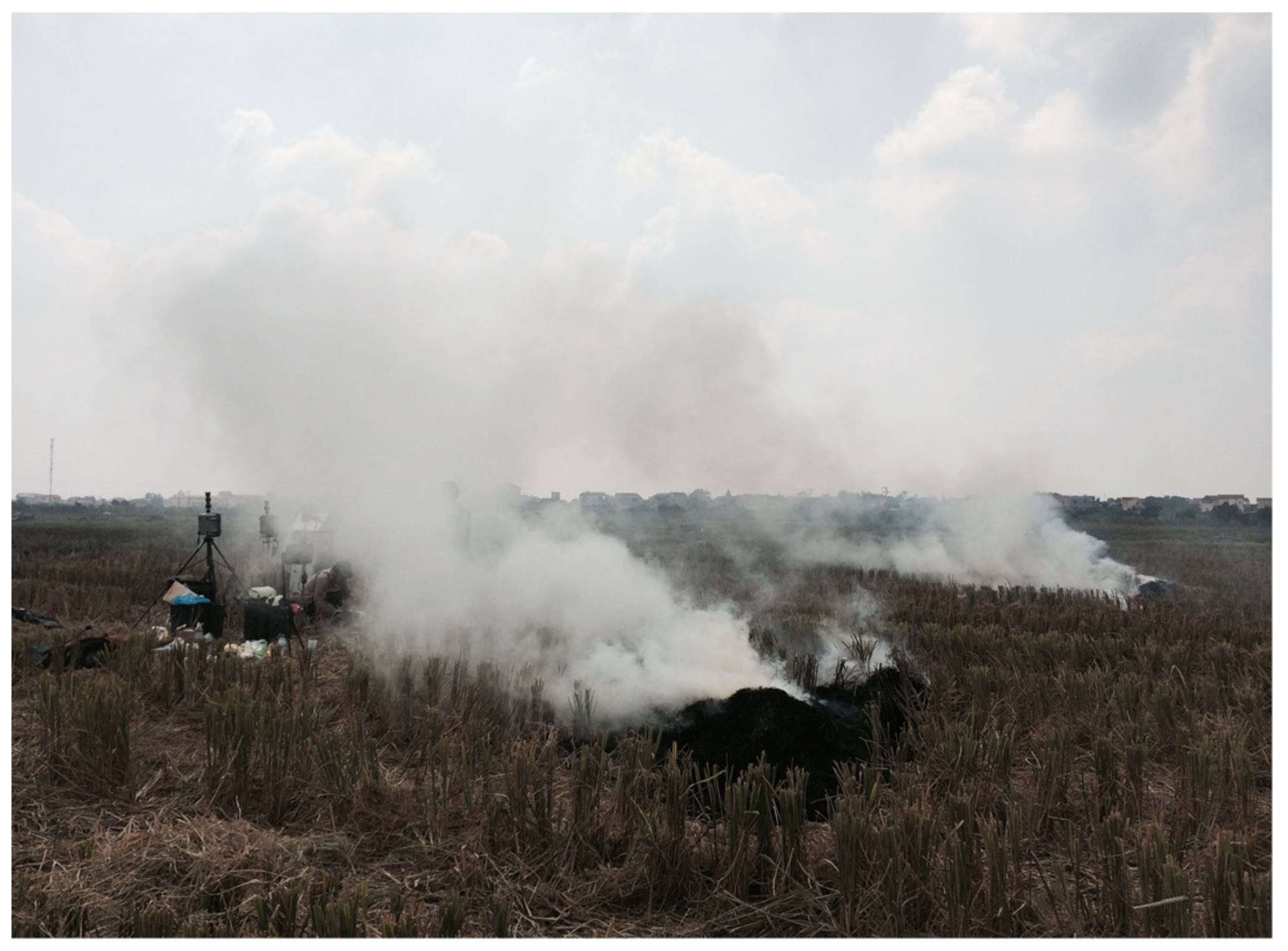
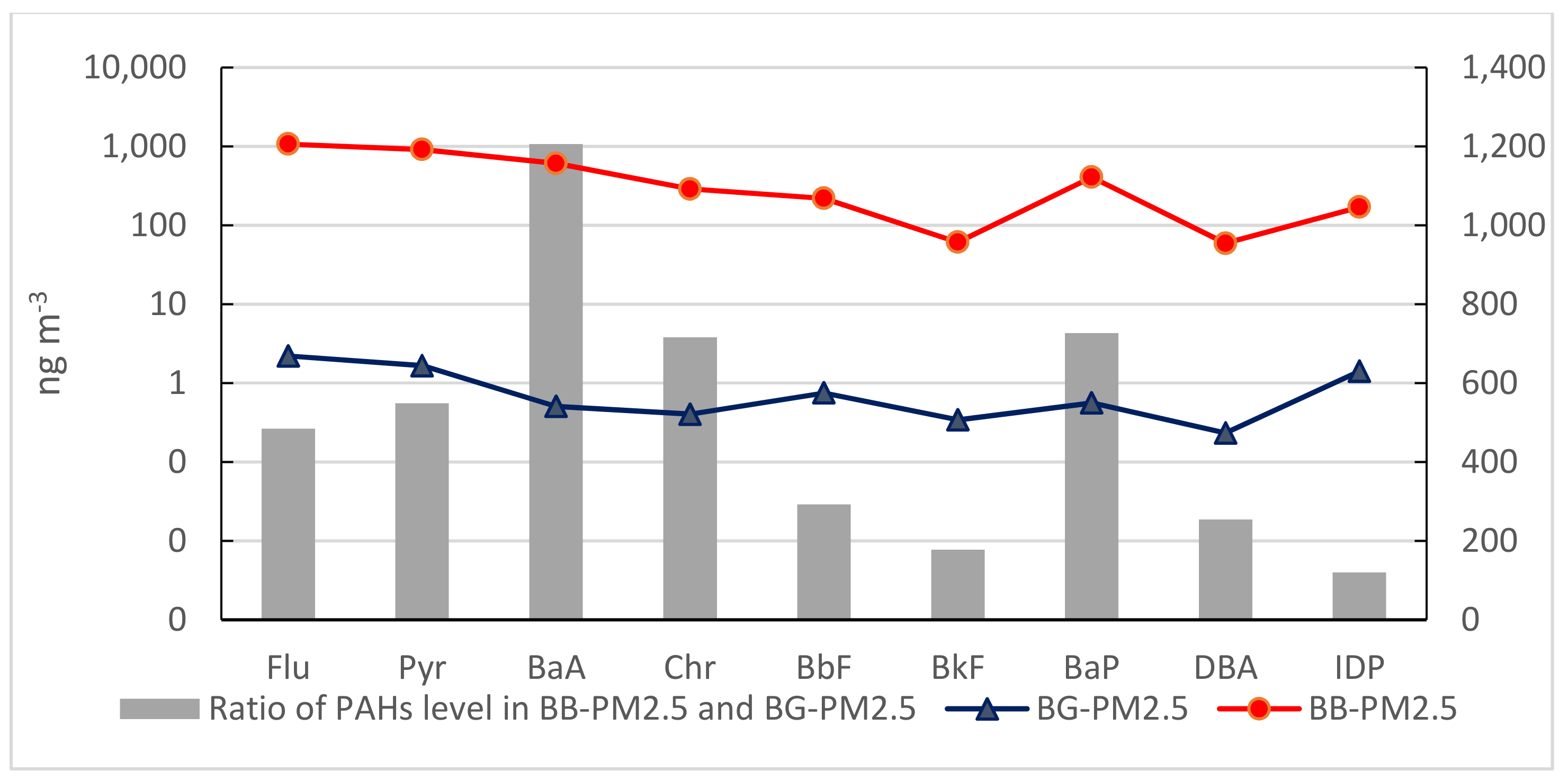
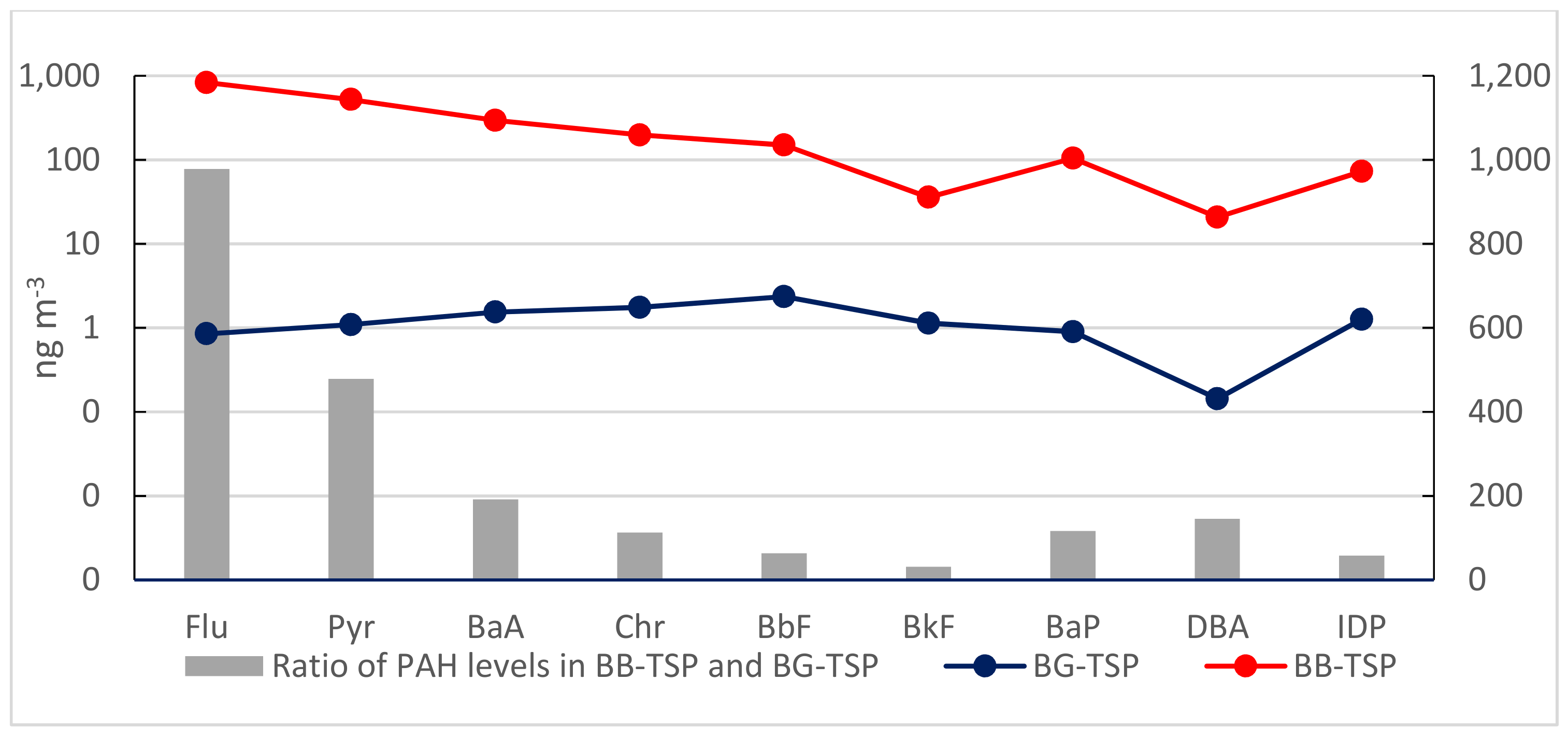

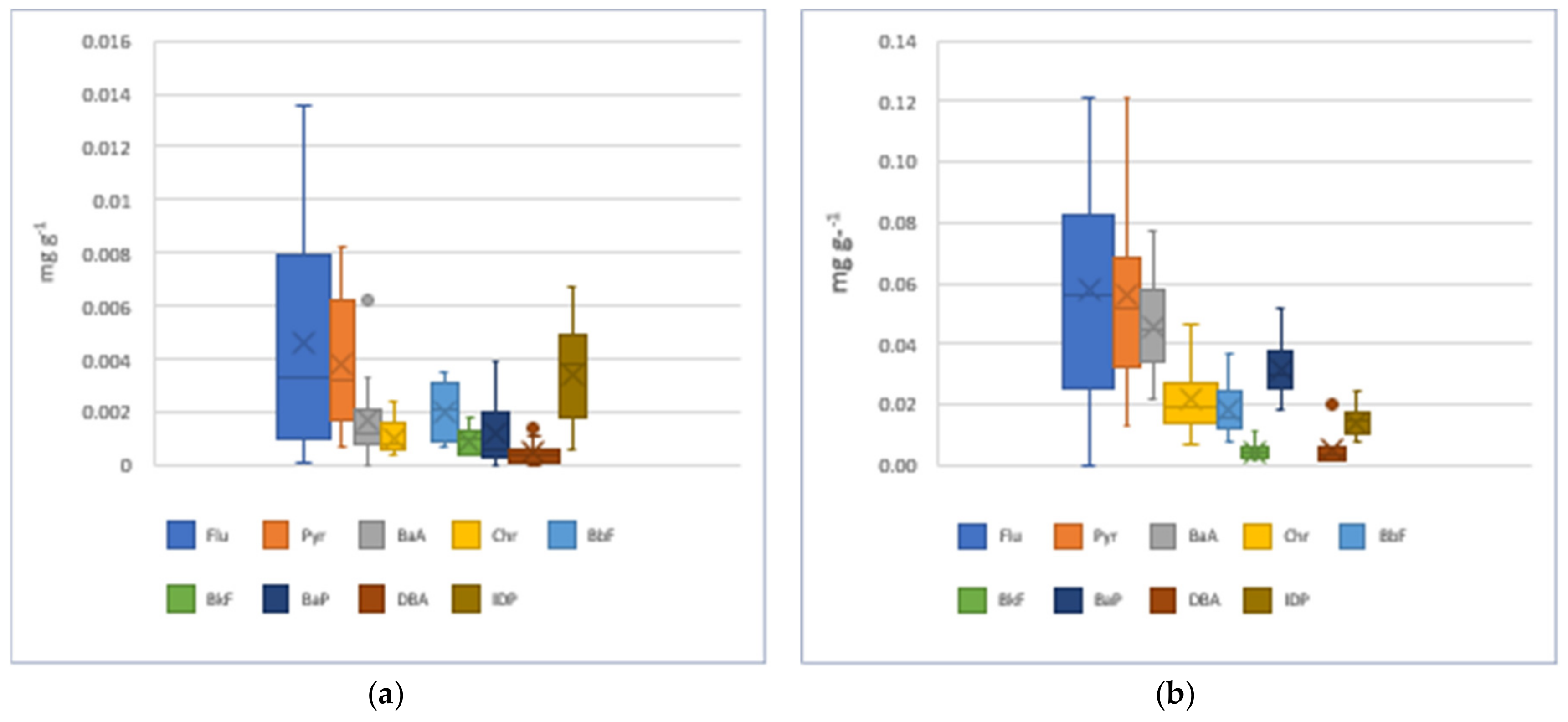
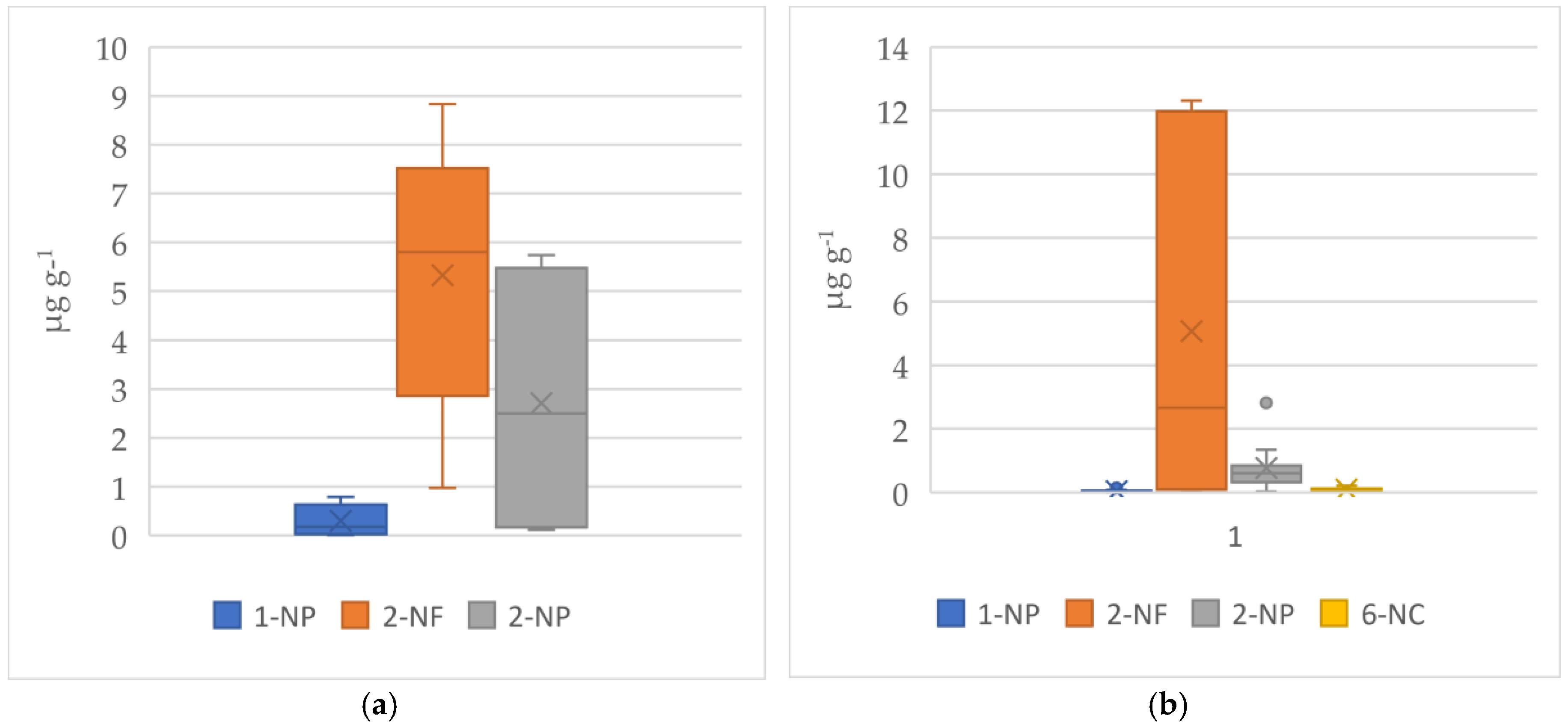
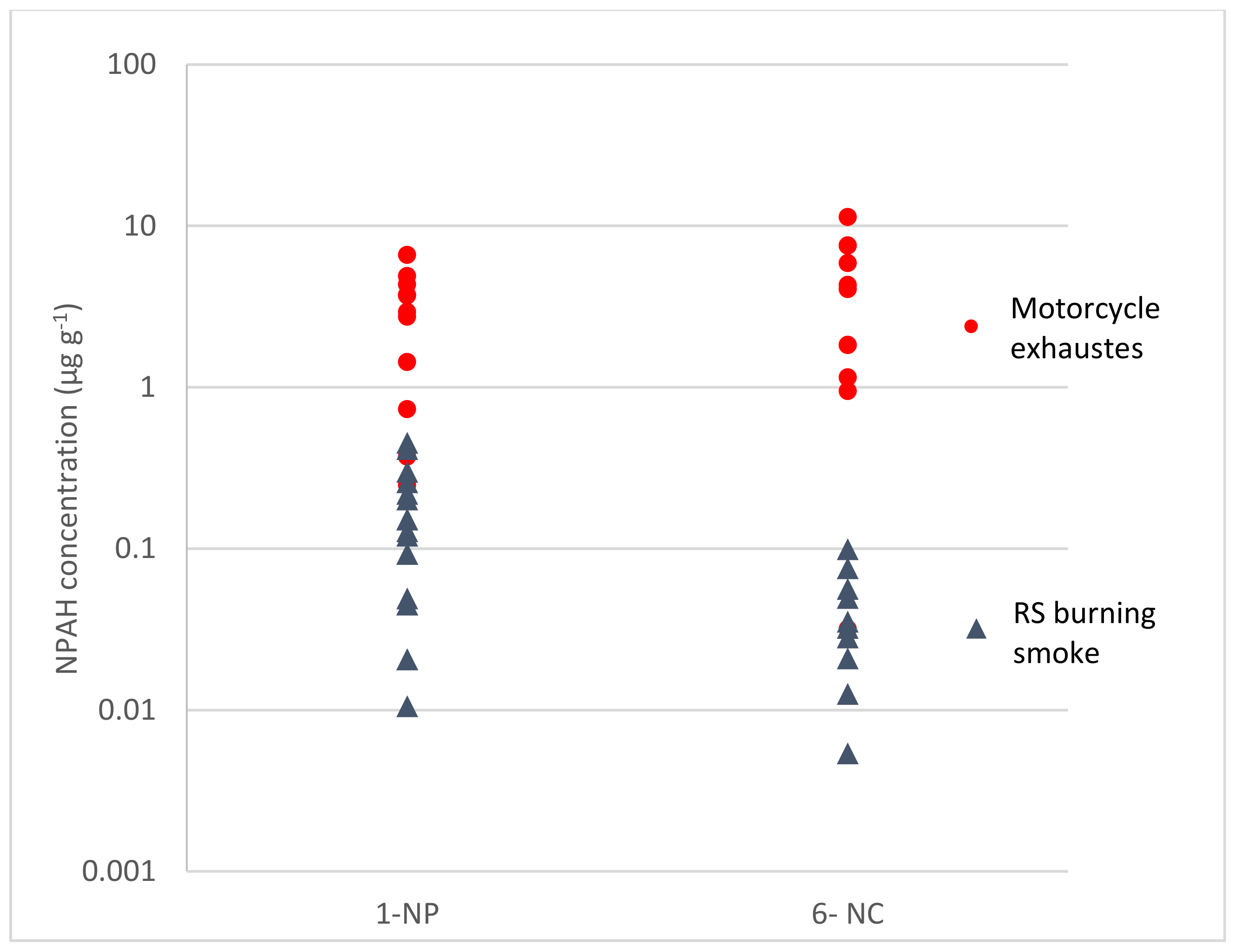
| PAHs (ng m−3) | BG 1, PM2.5 | BB 2, PM2.5 | BG, TSP | BB, TSP | ||||
|---|---|---|---|---|---|---|---|---|
| Autumn-Winter | Spring-Summer | Autumn-Winter | Spring-Summer | Autumn-Winter | Spring-Summer | Autumn-Winter | Spring-Summer | |
| Flu | 4.46 ± 1.71 | 0.28 ± 0.34 | 1219.6 ± 1208.1 | 923.1 ± 911.2 | 1.52 ± 1.28 | 0.27 ± 0.20 | 735.5 ± 678.4 | 996.4 ± 788.9 |
| Pyr | 3.09 ± 0.84 | 0.44 ± 0.32 | 1166.0 ± 1150.5 | 695.8 ± 666.0 | 1.87 ± 1.22 | 0.43 ± 0.24 | 571.7 ± 499.2 | 605.0 ± 507.8 |
| BaA | 0.71 ± 0.57 | 0.34 ± 0.31 | 793.4 ± 566.3 | 455.1 ± 250.3 | 3.08 ± 2.99 | 0.22 ± 0.22 | 668.1 ± 572.3 | 164.9 ± 125.0 |
| Chr | 0.69 ± 0.37 | 0.16 ± 0.09 | 409.1 ± 292.2 | 185.7 ± 134.6 | 3.37 ± 2.95 | 0.37 ± 0.21 | 301.9 ± 219.7 | 177.8 ± 112.2 |
| BbF | 1.14 ± 0.55 | 0.42 ± 0.23 | 172.5 ± 132.4 | 261.0 ± 139.5 | 4.36 ± 3.31 | 0.64 ± 0.51 | 160.1 ± 91.0 | 158.8 ± 96.0 |
| BkF | 0.55 ± 0.29 | 0.17 ± 0.08 | 93.9 ± 75.2 | 32.9 ± 21.3 | 2.09 ± 1.53 | 0.32 ± 0.21 | 70.0 ± 42.8 | 21.4 ± 14.9 |
| BaP | 1.04 ± 0.80 | 0.15 ± 0.09 | 390.2 ± 289.7 | 424.2 ± 233.7 | 1.52 ± 1.11 | 0.37 ± 0.35 | 109.9 ± 63.6 | 110.9 ± 65.5 |
| DBA | 0.46 ± 0.18 | 0.05 ± 0.02 | 42.0 ± 42.7 | 74.1 ± 78.6 | 0.25 ± 0.22 | 0.05 ± 0.04 | 13.1 ± 10.5 | 28.3 ± 10.2 |
| IDP | 2.35 ± 1.23 | 0.61 ± 0.33 | 201.0 ± 151.6 | 144.0 ± 104.9 | 1.87 ± 1.08 | 0.75 ± 0.40 | 69.8 ± 68.1 | 77.3 ± 55.1 |
| Total | 14.41 ± 3.69 | 2.60 ± 1.31 | 4487.6 ± 3850.1 | 3064.1 ± 2370.3 | 19.92 ± 15.37 | 3.41 ± 1.93 | 2700.1 ± 1965.3 | 2340.8 ± 1732.8 |
| PAHs (µg g−1) | BG 1, PM2.5 | BB2, PM2.5 | BG, TSP | BB, TSP | ||||
|---|---|---|---|---|---|---|---|---|
| Autumn-Winter | Spring-Summer | Autumn-Winter | Spring-Summer | Autumn-Winter | Spring-Summer | Autumn-Winter | Spring-Summer | |
| Flu | 7.91 ± 3.71 | 1.57 ± 1.94 | 71.28 ± 41.16 | 46.36 ± 31.87 | 5.29 ± 3.90 | 2.59 ± 1.96 | 54.18 ± 32.98 | 72.37 ± 36.80 |
| Pyr | 5.35 ± 2.03 | 2.21± 1.95 | 68.15 ± 40.91 | 44.97 ± 19.82 | 6.68 ± 3.59 | 4.10 ± 2.06 | 39.01 ± 16.28 | 42.28 ± 22.83 |
| BaA | 1.33 ± 1.13 | 1.76 ± 1.88 | 55.15 ± 13.19 | 37.48 ± 11.77 | 10.60 ± 8.93 | 2.15 ± 2.28 | 65.51 ± 40.82 | 15.20 ± 12.28 |
| Chr | 1.26 ± 0.74 | 0.76 ± 0.47 | 30.07 ± 9.27 | 14.88 ± 4.89 | 11.57 ± 8.50 | 3.45 ± 1.78 | 38.32 ± 37.21 | 16.25 ± 10.44 |
| BbF | 2.04 ± 1.13 | 1.98 ± 0.91 | 12.31 ± 4.29 | 22.89 ± 8.31 | 15.26 ± 10.08 | 5.99 ± 4.56 | 19.21 ± 12.32 | 15.22 ± 11.74 |
| BkF | 0.99 ± 0.57 | 0.80 ± 0.38 | 6.52 ± 2.32 | 2.74 ± 1.02 | 7.35 ± 4.67 | 2.97 ± 1.66 | 9.19 ± 7.30 | 1.82 ± 1.08 |
| BaP | 1.72 ± 1.68 | 0.68 ± 0.52 | 27.67 ± 8.91 | 35.26 ± 8.97 | 5.32 ± 3.13 | 3.39 ± 3.03 | 12.94 ± 5.78 | 10.15 ± 7.47 |
| DBA | 0.67 ± 0.50 | 0.19 ± 0.15 | 2.64 ± 1.62 | 6.66 ± 6.29 | 0.88 ± 0.65 | 0.50 ± 0.41 | 1.37 ± 0.66 | 3.46 ± 3.31 |
| IDP | 4.06 ± 2.26 | 2.87 ± 1.47 | 14.53 ± 5.77 | 14.04 ± 4.58 | 6.73 ± 3.01 | 7.18 ± 3.75 | 7.01 ± 3.58 | 6.59 ± 6.75 |
| Total | 25.34 ± 9.15 | 12.81 ± 7.84 | 288.30 ± 114.76 | 225.28 ± 48.05 | 69.68 ± 44.97 | 32.33 ± 16.81 | 246.74 ± 72.94 | 183.34 ± 95.79 |
| The Ratios of Each PAHs Relative to BkF for PM2.5 | |||||||
| Ratios 1 | Flu/BkF | Pyr/BkF | BaA/BkF | Chr/BkF | BaP/BkF | DBA/BkF | IDP/BkF |
| BG samples (the present study) | |||||||
| 5.55 ± 6.88 | 4.97 ± 4.98 | 2.43 ± 2.70 | 1.15 ± 0.42 | 1.23 ± 0.76 | 0.48 ± 0.30 | 3.82 ± 1.13 | |
| BB samples (the present study) | |||||||
| 14.84 ±1 1.0 | 13.08 ± 9.54 | 11.69 ± 9.77 | 5.11 ± 3.36 | 9.14 ± 6.60 | 2.11 ± 4.06 | 3.83 ± 1.74 | |
| BB samples (Kim Oanh et al., 2011) 2 | |||||||
| 10 | 5.8 | 2.4 | 3.4 | 2.6 | |||
| The Ratios of Each PAHs Relative to BkF for TSP | |||||||
| Ratios 1 | Flu/BkF | Pyr/BkF | BaA/BkF | Chr/BkF | BaP/BkF | DBA/BkF | IDP/BkF |
| BG samples (the present study) | |||||||
| 0.80 ± 0.43 | 1.5 ± 0.97 | 1.14 ± 1.14 | 1.44 ± 0.51 | 1.08 ± 0.62 | 0.18 ± 0.15 | 2.01 ± 1.11 | |
| BB samples (the present study) | |||||||
| 28.39 ± 0.93 | 15.74 ± 11.82 | 7.75 ± 2.32 | 5.81 ± 3.27 | 3.85 ± 1.92 | 1.14 ± 1.12 | 3.71 ± 2.75 | |
| NPAHs (µg g−1) | BG 1-PM2.5 | BB 2-PM2.5 | ||||
|---|---|---|---|---|---|---|
| Autumn-Winter | Spring-Summer | Average 1 | Autumn-Winter | Spring-Summer | Average 3 | |
| 1-NP | 0.51 ± 0.25 | 0.04 ± 0.03 | 0.34 ± 0.31 | 0.07 ± 0.04 | 0.03 ± 0.01 | 0.05 ± 0.03 |
| 2-NF | 6.2 ± 2.1 | 0.5 ± 0.7 | 5.33 ± 2.84 | 7.1 ± 4.9 | 0.09 ± 0.01 | 5.07 ± 5.22 |
| 2-NP | 2.06 ± 3.19 | 2.34 ± 3.3 | 2.71±2.92 | 0.24 ± 0.28 | 1.23 ± 0.77 | 0.76 ± 0.74 |
| 6-NC | ND 4 | ND 4 | ND 4 | 0.04 ± 0.02 | 0.15 ± 0.04 | 0.09 ± 0.06 |
| Ratios | ||||||
| 1-NP/Pyr | 0.105 ± 0.101 | 0.036 ± 0.03 | 0.095 ± 0.086 | 0.0032 ± 0.0032 | 0.0009 ± 0.0004 | 0.0019 ± 0.0024 |
| 2-NF/1-NP | 196.5 ± 404.2 | 15.11 ± 21.37 | 168.83 ± 367.83 | 131.04 ± 80.07 | 2.93 ± 0.78 | 131.04 ± 80.07 |
| NPAHs (µg g−1) | BG-TSP | BB-TSP | ||||
| 1-NP | 0.035 ± 0.027 | 0.018 ± 0.008 | 0.03 ± 0.02 | 0.18 ± 0.14 | 0.18 ± 0.15 | 0.18 ± 0.14 |
| 2-NF | 3.73 ± 3.27 | 1.13 ± 1.12 | 1.99 ± 2.17 | 15.8 ± 12.82 | 0.02 ± 0.02 | 6.33 ± 10.76 |
| 2-NP | 0.13 ± 0.195 | 0.74 ± 0.35 | 0.46 ± 0.42 | 0.27 ± 0.37 | 0.77 ± 0.42 | 0.54 ± 0.46 |
| 6-NC | 0.047 ± 0.042 | 0.06 ± 0.049 | 0.06 ±0.05 | 0.03 ± 0.02 | 0.04 ± 0.02 | 0.04 ± 0.03 |
| Ratios | ||||||
| 1-NP/Pyr | 0.004 ± 0.002 | 0.003 ± 0.001 | 0.004 ± 0.002 | 0.005 ± 0.003 | 0.004 ± 0.002 | 0.004 ± 0.003 |
| 2-NF/1-NP | 203.6 ± 253.9 | 45.6 ± 41.1 | 98.3 ± 143.4 | 171.7 ± 49.1 | 0.61 ± 0.45 | 69.1 ± 96.9 |
© 2019 by the authors. Licensee MDPI, Basel, Switzerland. This article is an open access article distributed under the terms and conditions of the Creative Commons Attribution (CC BY) license (http://creativecommons.org/licenses/by/4.0/).
Share and Cite
Pham, C.-T.; Boongla, Y.; Nghiem, T.-D.; Le, H.-T.; Tang, N.; Toriba, A.; Hayakawa, K. Emission Characteristics of Polycyclic Aromatic Hydrocarbons and Nitro-Polycyclic Aromatic Hydrocarbons from Open Burning of Rice Straw in the North of Vietnam. Int. J. Environ. Res. Public Health 2019, 16, 2343. https://doi.org/10.3390/ijerph16132343
Pham C-T, Boongla Y, Nghiem T-D, Le H-T, Tang N, Toriba A, Hayakawa K. Emission Characteristics of Polycyclic Aromatic Hydrocarbons and Nitro-Polycyclic Aromatic Hydrocarbons from Open Burning of Rice Straw in the North of Vietnam. International Journal of Environmental Research and Public Health. 2019; 16(13):2343. https://doi.org/10.3390/ijerph16132343
Chicago/Turabian StylePham, Chau-Thuy, Yaowatat Boongla, Trung-Dung Nghiem, Huu-Tuyen Le, Ning Tang, Akira Toriba, and Kazuichi Hayakawa. 2019. "Emission Characteristics of Polycyclic Aromatic Hydrocarbons and Nitro-Polycyclic Aromatic Hydrocarbons from Open Burning of Rice Straw in the North of Vietnam" International Journal of Environmental Research and Public Health 16, no. 13: 2343. https://doi.org/10.3390/ijerph16132343
APA StylePham, C.-T., Boongla, Y., Nghiem, T.-D., Le, H.-T., Tang, N., Toriba, A., & Hayakawa, K. (2019). Emission Characteristics of Polycyclic Aromatic Hydrocarbons and Nitro-Polycyclic Aromatic Hydrocarbons from Open Burning of Rice Straw in the North of Vietnam. International Journal of Environmental Research and Public Health, 16(13), 2343. https://doi.org/10.3390/ijerph16132343





